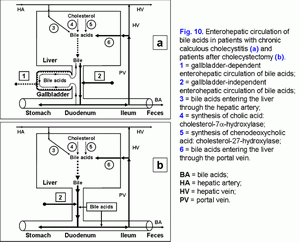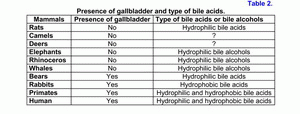
Русский | English
Protective role of the gallbladder
|
MammalsIn mammals (rats) that do not have the gallbladder, only the hydrophilic hepatoprotective bile acids are only synthesized; as for the secondary hydrophobic hepatotoxic bile acids, they are formed in small quantities or are poorly absorbed in the ileum and the colon (table 2). Since a long stagnation in the gallbladder may promote the formation of gallstones, the gallbladder may be absent in mammals which can manage without food and water for a long period of time (camels, deer) (1). Since the size of the gallbladder must be proportional to the size of the liver, the gallbladder may be absent in big mammals (elephants, rhinoceros, whales) because of their anatomical peculiarities (2). In these mammals there is a considerable synthesis of bile alcohols, which are poorly solubilize cholesterol (2). In mammals that have the gallbladder (humans, monkeys, rabbits) both the hydrophilic and hydrophobic bile acids may be synthesized (table 2). The secondary hydrophobic hepatotoxic bile acids can be formed in large quantities, but they are poorly absorbed in the ileum and the colon (1-3). Since a long stagnation in the gallbladder may promote the formation of gallstones, only the hydrophilic bile acids are synthesized in mammals that fall into long hibernation (bears), but the secondary bile acids are also hydrophilic (1-3). Therefore, the basic role of the gallbladder in mammals in which hydrophobic hepatotoxic bile acids are synthesized or formed, is the protection of the liver from their effect by means of bile acids accumulation in the gallbladder and lowering the number of the cycles of enterohepatic circulation. The mammals in which the hydrophobic hepatotoxic bile acids are synthesized or formed must have the gallbladder. Those mammals in which the hydrophilic hepatoprotective bile acids are synthesized and the hydrophobic hepatotoxic bile acids are formed in small quantities, may manage without it. The mammals, in which bile alcohols are synthesized in large amounts, do not have the gallbladder. HumanThe excessive hepatic bile passage from the liver into the duodenum increases the frequency of the gallbladder independent enterohepatic circulation of bile acids. The gallbladder-independent enterohepatic circulation of bile acids in patients with the cholesterol gallstone disease (CGD) or after cholecystectomy is raised (fig. 10). It results in: 1) the increase of the hydrophobic hepatotoxic DCA formation and its accumulation in hepatocytes (table 3) (4), 2) the formation of morphological changes in the liver (nonspecific reactive hepatitis) (5) and 3) the appearance of cholestasis (6). The risk of cancer of the liver, the pancreas, the small intestine, and the colon increases as well (7-15). The increases of DCA, participating in the enterohepatic circulation, and of other toxic agents in the hepatic bile can result in chronic pancreatitis and duodeno-gastral reflux (16-19). Hence, the basic role of the gallbladder in a human is a protective. The gallbladder decrease the formation of the secondary hydrophobic hepatotoxic bile acids (DCA and LCA) by accumulating the primary bile acids (CA and CDCA) in the gallbladder and by reducing their concentration in the gallbladder-independent enterohepatic circulation, thereby protecting the liver, the mucosa of the stomach, the gallbladder, and the colon from their effect. Besides, the increase of the cycles of enterohepatic circulation in a human can determine the raised enterohepatic circulation of estrogens, progesterons and the formation of their active metabolites: 1. а) 16α-hydroxy-estrone (it activates proliferation and induces breast cancer); b) 4-hydroxyestrone (proliferation, cancer); c) 2-hydroxy-estrone (it stimulates fat accumulation in the body of a human) (20-22); 2. а) pregnanolone (inflammation, cholestasis) (23); b) pregnandiol (inflammation, cholestasis) (23). Probably, the excessive formation of these “active” metabolites and DCA determine the increased risk of cancer of various sites (13). 9.4% of the patients with gallstones and cholecystectomized patients have cancer of various sites (cancer of the liver, the pancreas, the colon and the small intestine, breast cancer in women) (13, 14). For women, who underwent cholecystectomy before the age of 50 (i.e. before menopause), the risk of colon cancer is higher than for women who underwent cholecystectomy at the age over 50 (11). Estrogens intensify the cancer effect of the hydrophobic DCA (24). The concentration of total bile acids in blood serum is 3 times higher and the risk of intrahepatic cholestasis is 2.5 times higher in cholecystectomized pregnant women (19%) than in noncholecystectomized pregnant women (25). Children with inborn absence of the gallbladder have infringements of the function of the liver and lag behind in physical development (6). Probably, the evolution of a human lacking the gallbladder would have been extremely difficulty. The role of the gallbladder and gallbladder bile in digestionThe evacuation volume of the gallbladder depends on the quality and quantity of accepted food. The gallbladder is emptied to a greater extent when the fat food is accepted (1). Since the gallbladder is contracted in 5-20 minutes after food is available in a stomach, and “the gastric chyme” moves from the stomach into the duodenum only 1-3 hours later, the role of the gallbladder bile in digestion may be insignificant. The gallbladder bile, coming into the duodenum, stimulates the peristalsis of the intestine and promotes the cleaning of the intestine for “a new gastric chyme”. The hepatic and gallbladder bile volumes and the bile acids concentration, participating in the first circle of gallbladder-dependent and gallbladder-independent enterohepatic circulation, determine the bile acids-stimulated secretion of the hepatic bile that in a greater extent participates in digestion. Conclusion:Thus, the basic role of the gallbladder in a human is the protection of the liver, the mucosa of the stomach, the gallbladder and the colon from the effect of hepatotoxic hydrophobic bile acids and the regulation of serum lipids level. If the genetics of the biosynthesis of bile acids in a human had evolved in a different way (by analogy with bears [presence of cholesterol-7β-hydroxylase instead of cholesterol-7α-hydroxylase] or rats [presence of cholesterol-6β-hydroxylase instead of cholesterol-12α-hydroxylase]), a human being would have probably never suffered from gallstone disease, some hepatic and colon diseases (liver cirrhosis, colorectal cancer) (2, 26, 27, 28). This model of the gallbladder bile formation that we have worked out provides a better understanding of the causes of the diseases of the hepatobiliary zone. It also allows to foresee various trends in their treatment and prevention and to make prognosis of the appearance of various disorders in hepato-biliarypancreato-duodenal-gastral region after cholecystectomy.References:
|
|
|


